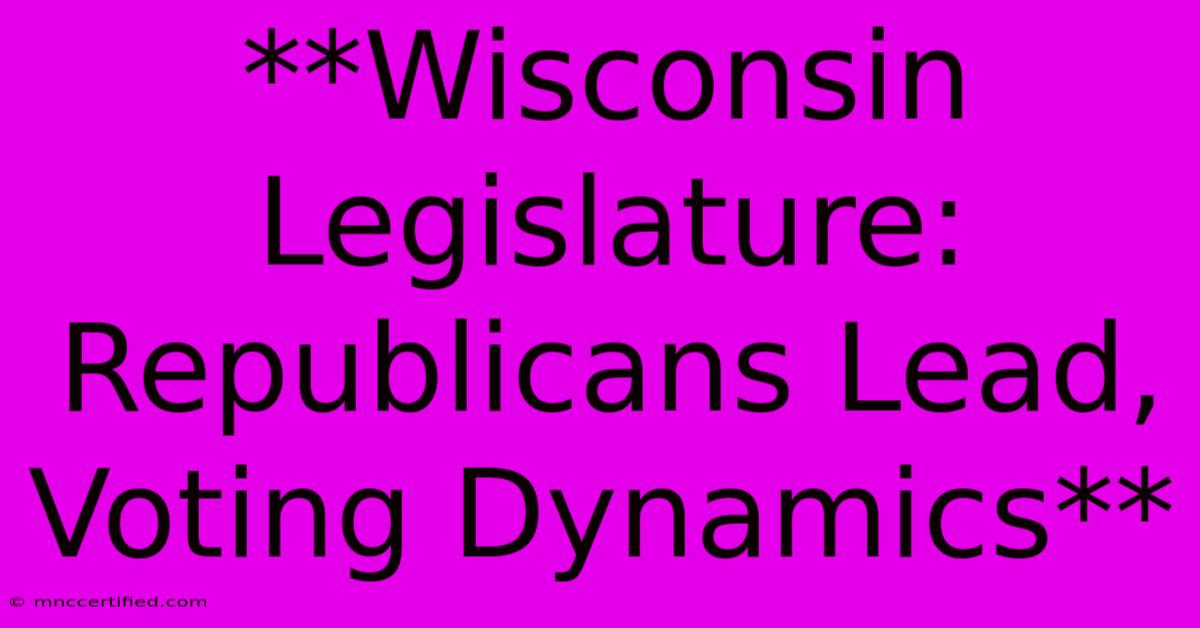**Wisconsin Legislature: Republicans Lead, Voting Dynamics**

Table of Contents
Wisconsin Legislature: Republicans in Control, Understanding Voting Dynamics
The Wisconsin Legislature, comprised of the Assembly and the Senate, plays a crucial role in shaping the state's policies and laws. Currently, Republicans hold a strong majority in both chambers, wielding significant influence over legislation. Understanding the dynamics of voting patterns and the factors influencing them is essential for navigating the political landscape of Wisconsin.
The Republican Dominance
As of 2023, the Wisconsin Assembly consists of 64 Republicans and 35 Democrats. This significant majority grants Republicans the power to advance their agenda, passing bills and setting the legislative agenda. Similarly, the Wisconsin Senate comprises 21 Republicans and 12 Democrats, solidifying Republican control over the legislative process.
Factors Influencing Voting Patterns
Several factors contribute to the current political landscape in Wisconsin.
1. Geographic Distribution: Wisconsin's voting patterns are heavily influenced by the distribution of urban and rural populations. Urban areas tend to lean Democratic, while rural areas tend to favor Republican candidates. This geographic divide creates a distinct political landscape, with urban centers often supporting progressive policies and rural areas favoring conservative stances.
2. Partisan Polarization: The political landscape in the United States, including Wisconsin, has become increasingly polarized. This polarization manifests in voters' strong affiliations with specific political parties and their tendency to vote consistently for those parties' candidates. Partisan loyalty plays a significant role in shaping voting patterns and influencing legislative outcomes.
3. Economic Concerns: Economic issues, such as employment rates, taxes, and the cost of living, consistently influence voter decisions. Candidates who address these concerns effectively often find favor with voters. The state of the economy in Wisconsin, particularly its impact on different communities, can impact voter turnout and preferences.
4. Social Issues: Social issues, such as abortion, gun control, and education, are also significant factors in Wisconsin's political landscape. These issues often draw strong opinions from voters, influencing their choices at the ballot box.
5. Gerrymandering: The process of redistricting, which occurs every ten years after the census, has been a subject of debate in Wisconsin. Some argue that the current legislative districts are drawn to favor one party over another, potentially impacting the fairness and accuracy of electoral outcomes.
The Impact of Republican Control
Republican control of the Wisconsin Legislature has had a significant impact on the state's policies. Some key examples include:
- Budget priorities: Republicans have prioritized tax cuts and limited government spending, leading to changes in areas such as education and healthcare funding.
- Social legislation: Republican lawmakers have introduced legislation addressing issues such as abortion rights, gun control, and education curriculum.
- Environmental policies: Republican control has influenced environmental regulations, impacting issues such as air and water quality.
Navigating the Political Landscape
Understanding the dynamics of the Wisconsin Legislature and the factors influencing voting patterns is crucial for engaged citizens and political observers. By staying informed about current legislation, key issues, and the perspectives of different political actors, individuals can contribute to shaping the state's political future.
This article provides a starting point for exploring the complex political landscape of Wisconsin. It's important to continue researching and engaging with various sources to develop a nuanced understanding of the issues and the diverse perspectives within the state.

Thank you for visiting our website wich cover about **Wisconsin Legislature: Republicans Lead, Voting Dynamics** . We hope the information provided has been useful to you. Feel free to contact us if you have any questions or need further assistance. See you next time and dont miss to bookmark.
Featured Posts
-
Is Lipedema Treatment Covered By Insurance
Nov 07, 2024
-
Does Insurance Cover Myofunctional Therapy
Nov 07, 2024
-
Trumps Running Mate Jd Vance
Nov 07, 2024
-
What Is The Worst Health Insurance Company
Nov 07, 2024
-
Brugge 1 0 Aston Villa Mings Concedes Penalty
Nov 07, 2024